Lewy Body Dementia as a Distinct Diagnosis or Parkinson's Syndrome?
VerifiedAdded on 2020/11/23
|30
|11265
|381
Essay
AI Summary
This essay investigates the relationship between Lewy Body Dementia (LBD) and Parkinson's Syndrome (PD), exploring whether LBD is a distinct diagnosis or a part of PD. It examines the similarities and differences between the two conditions, including their symptoms, causes, and impact on patients' cognitive and motor functions. The study reviews relevant literature to determine the diagnostic challenges and healthcare implications. The essay delves into the research methodology, including research philosophy, design, approach, sampling, data collection and analysis, and ethical considerations. It discusses various themes related to LBD and PD, such as diagnosis, treatment, healthcare settings, the role of mental health counselors, and nursing interventions. The essay concludes by summarizing the findings and providing recommendations for future research and clinical practice. This assignment aims to assess whether LBD is a distinct diagnosis or a part of Parkinson’s syndrome, providing a comprehensive overview of the two conditions and their implications for healthcare providers and patients.
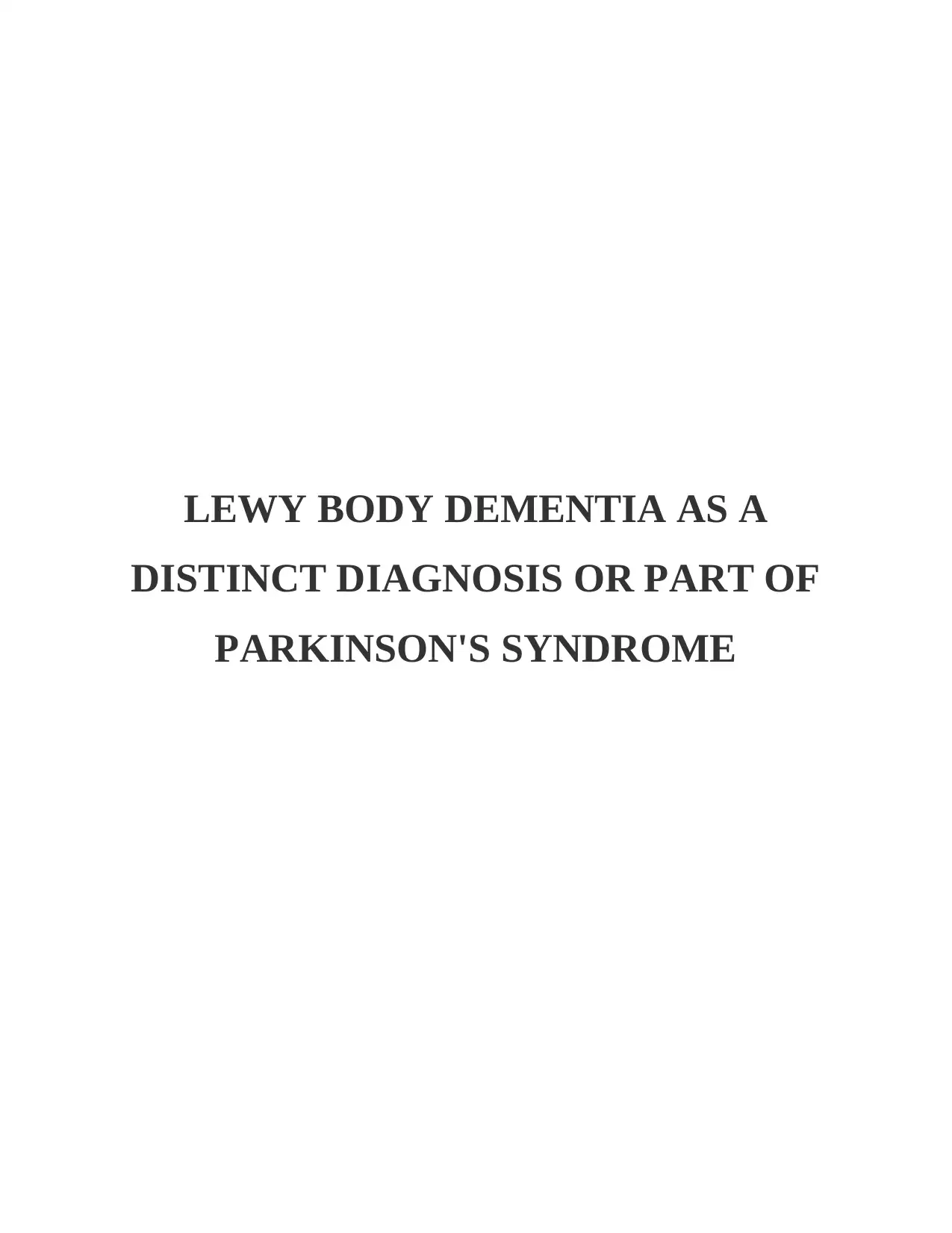
LEWY BODY DEMENTIA AS A
DISTINCT DIAGNOSIS OR PART OF
PARKINSON'S SYNDROME
DISTINCT DIAGNOSIS OR PART OF
PARKINSON'S SYNDROME
Paraphrase This Document
Need a fresh take? Get an instant paraphrase of this document with our AI Paraphraser
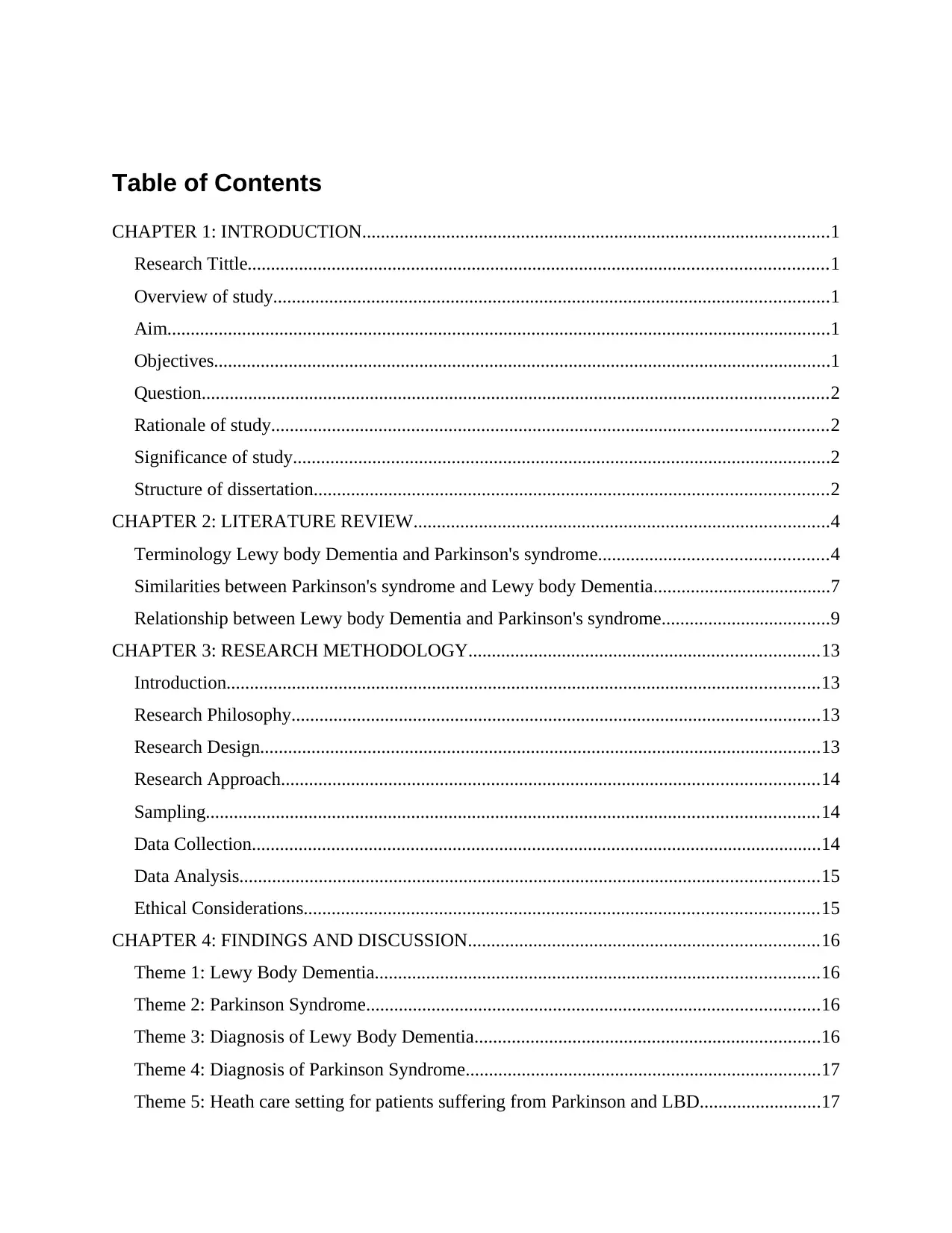
Table of Contents
CHAPTER 1: INTRODUCTION....................................................................................................1
Research Tittle............................................................................................................................1
Overview of study.......................................................................................................................1
Aim..............................................................................................................................................1
Objectives....................................................................................................................................1
Question......................................................................................................................................2
Rationale of study.......................................................................................................................2
Significance of study...................................................................................................................2
Structure of dissertation..............................................................................................................2
CHAPTER 2: LITERATURE REVIEW.........................................................................................4
Terminology Lewy body Dementia and Parkinson's syndrome.................................................4
Similarities between Parkinson's syndrome and Lewy body Dementia......................................7
Relationship between Lewy body Dementia and Parkinson's syndrome....................................9
CHAPTER 3: RESEARCH METHODOLOGY...........................................................................13
Introduction...............................................................................................................................13
Research Philosophy.................................................................................................................13
Research Design........................................................................................................................13
Research Approach...................................................................................................................14
Sampling...................................................................................................................................14
Data Collection..........................................................................................................................14
Data Analysis............................................................................................................................15
Ethical Considerations..............................................................................................................15
CHAPTER 4: FINDINGS AND DISCUSSION...........................................................................16
Theme 1: Lewy Body Dementia...............................................................................................16
Theme 2: Parkinson Syndrome.................................................................................................16
Theme 3: Diagnosis of Lewy Body Dementia..........................................................................16
Theme 4: Diagnosis of Parkinson Syndrome............................................................................17
Theme 5: Heath care setting for patients suffering from Parkinson and LBD..........................17
CHAPTER 1: INTRODUCTION....................................................................................................1
Research Tittle............................................................................................................................1
Overview of study.......................................................................................................................1
Aim..............................................................................................................................................1
Objectives....................................................................................................................................1
Question......................................................................................................................................2
Rationale of study.......................................................................................................................2
Significance of study...................................................................................................................2
Structure of dissertation..............................................................................................................2
CHAPTER 2: LITERATURE REVIEW.........................................................................................4
Terminology Lewy body Dementia and Parkinson's syndrome.................................................4
Similarities between Parkinson's syndrome and Lewy body Dementia......................................7
Relationship between Lewy body Dementia and Parkinson's syndrome....................................9
CHAPTER 3: RESEARCH METHODOLOGY...........................................................................13
Introduction...............................................................................................................................13
Research Philosophy.................................................................................................................13
Research Design........................................................................................................................13
Research Approach...................................................................................................................14
Sampling...................................................................................................................................14
Data Collection..........................................................................................................................14
Data Analysis............................................................................................................................15
Ethical Considerations..............................................................................................................15
CHAPTER 4: FINDINGS AND DISCUSSION...........................................................................16
Theme 1: Lewy Body Dementia...............................................................................................16
Theme 2: Parkinson Syndrome.................................................................................................16
Theme 3: Diagnosis of Lewy Body Dementia..........................................................................16
Theme 4: Diagnosis of Parkinson Syndrome............................................................................17
Theme 5: Heath care setting for patients suffering from Parkinson and LBD..........................17
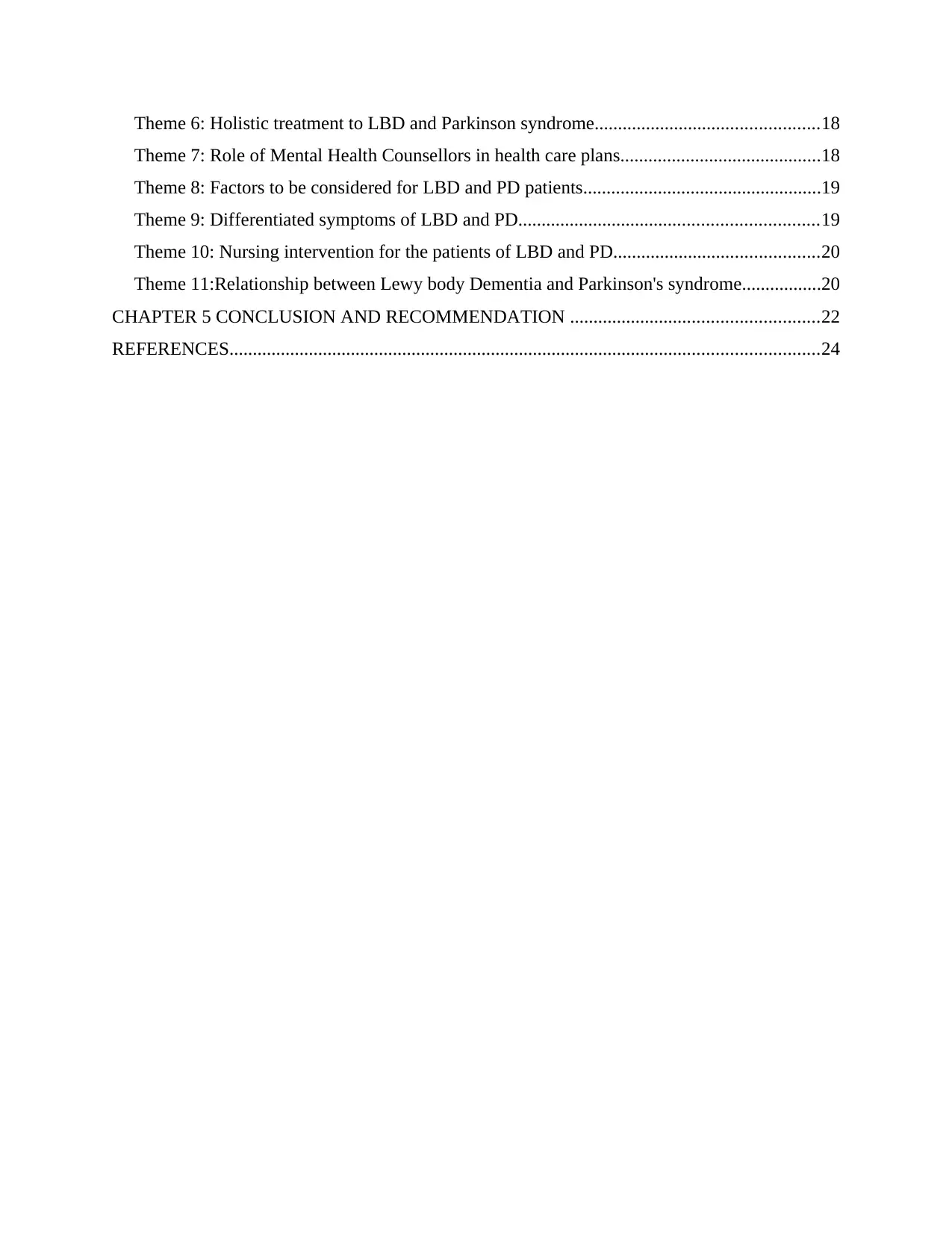
Theme 6: Holistic treatment to LBD and Parkinson syndrome................................................18
Theme 7: Role of Mental Health Counsellors in health care plans...........................................18
Theme 8: Factors to be considered for LBD and PD patients...................................................19
Theme 9: Differentiated symptoms of LBD and PD................................................................19
Theme 10: Nursing intervention for the patients of LBD and PD............................................20
Theme 11:Relationship between Lewy body Dementia and Parkinson's syndrome.................20
CHAPTER 5 CONCLUSION AND RECOMMENDATION .....................................................22
REFERENCES..............................................................................................................................24
Theme 7: Role of Mental Health Counsellors in health care plans...........................................18
Theme 8: Factors to be considered for LBD and PD patients...................................................19
Theme 9: Differentiated symptoms of LBD and PD................................................................19
Theme 10: Nursing intervention for the patients of LBD and PD............................................20
Theme 11:Relationship between Lewy body Dementia and Parkinson's syndrome.................20
CHAPTER 5 CONCLUSION AND RECOMMENDATION .....................................................22
REFERENCES..............................................................................................................................24
⊘ This is a preview!⊘
Do you want full access?
Subscribe today to unlock all pages.

Trusted by 1+ million students worldwide
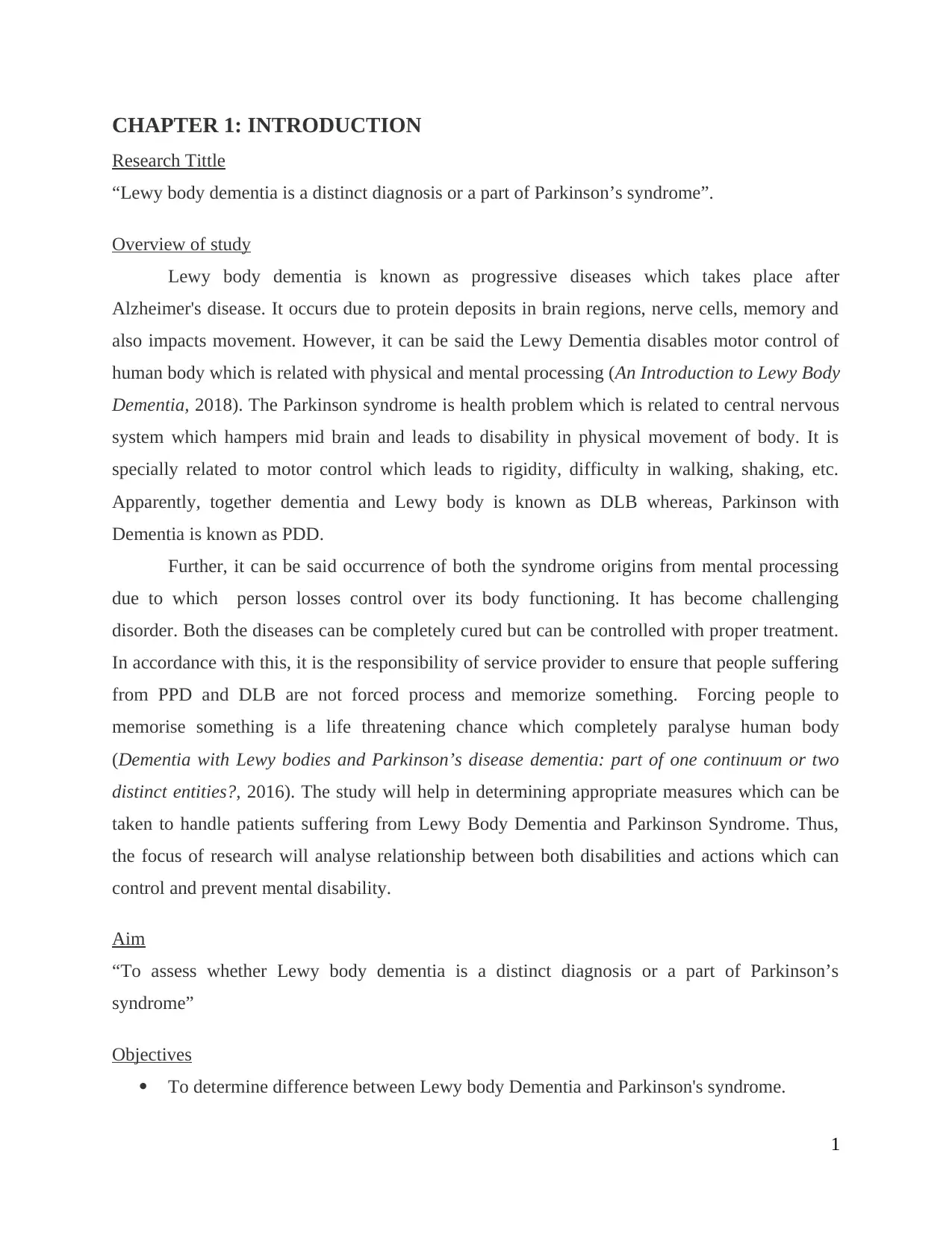
CHAPTER 1: INTRODUCTION
Research Tittle
“Lewy body dementia is a distinct diagnosis or a part of Parkinson’s syndrome”.
Overview of study
Lewy body dementia is known as progressive diseases which takes place after
Alzheimer's disease. It occurs due to protein deposits in brain regions, nerve cells, memory and
also impacts movement. However, it can be said the Lewy Dementia disables motor control of
human body which is related with physical and mental processing (An Introduction to Lewy Body
Dementia, 2018). The Parkinson syndrome is health problem which is related to central nervous
system which hampers mid brain and leads to disability in physical movement of body. It is
specially related to motor control which leads to rigidity, difficulty in walking, shaking, etc.
Apparently, together dementia and Lewy body is known as DLB whereas, Parkinson with
Dementia is known as PDD.
Further, it can be said occurrence of both the syndrome origins from mental processing
due to which person losses control over its body functioning. It has become challenging
disorder. Both the diseases can be completely cured but can be controlled with proper treatment.
In accordance with this, it is the responsibility of service provider to ensure that people suffering
from PPD and DLB are not forced process and memorize something. Forcing people to
memorise something is a life threatening chance which completely paralyse human body
(Dementia with Lewy bodies and Parkinson’s disease dementia: part of one continuum or two
distinct entities?, 2016). The study will help in determining appropriate measures which can be
taken to handle patients suffering from Lewy Body Dementia and Parkinson Syndrome. Thus,
the focus of research will analyse relationship between both disabilities and actions which can
control and prevent mental disability.
Aim
“To assess whether Lewy body dementia is a distinct diagnosis or a part of Parkinson’s
syndrome”
Objectives
To determine difference between Lewy body Dementia and Parkinson's syndrome.
1
Research Tittle
“Lewy body dementia is a distinct diagnosis or a part of Parkinson’s syndrome”.
Overview of study
Lewy body dementia is known as progressive diseases which takes place after
Alzheimer's disease. It occurs due to protein deposits in brain regions, nerve cells, memory and
also impacts movement. However, it can be said the Lewy Dementia disables motor control of
human body which is related with physical and mental processing (An Introduction to Lewy Body
Dementia, 2018). The Parkinson syndrome is health problem which is related to central nervous
system which hampers mid brain and leads to disability in physical movement of body. It is
specially related to motor control which leads to rigidity, difficulty in walking, shaking, etc.
Apparently, together dementia and Lewy body is known as DLB whereas, Parkinson with
Dementia is known as PDD.
Further, it can be said occurrence of both the syndrome origins from mental processing
due to which person losses control over its body functioning. It has become challenging
disorder. Both the diseases can be completely cured but can be controlled with proper treatment.
In accordance with this, it is the responsibility of service provider to ensure that people suffering
from PPD and DLB are not forced process and memorize something. Forcing people to
memorise something is a life threatening chance which completely paralyse human body
(Dementia with Lewy bodies and Parkinson’s disease dementia: part of one continuum or two
distinct entities?, 2016). The study will help in determining appropriate measures which can be
taken to handle patients suffering from Lewy Body Dementia and Parkinson Syndrome. Thus,
the focus of research will analyse relationship between both disabilities and actions which can
control and prevent mental disability.
Aim
“To assess whether Lewy body dementia is a distinct diagnosis or a part of Parkinson’s
syndrome”
Objectives
To determine difference between Lewy body Dementia and Parkinson's syndrome.
1
Paraphrase This Document
Need a fresh take? Get an instant paraphrase of this document with our AI Paraphraser
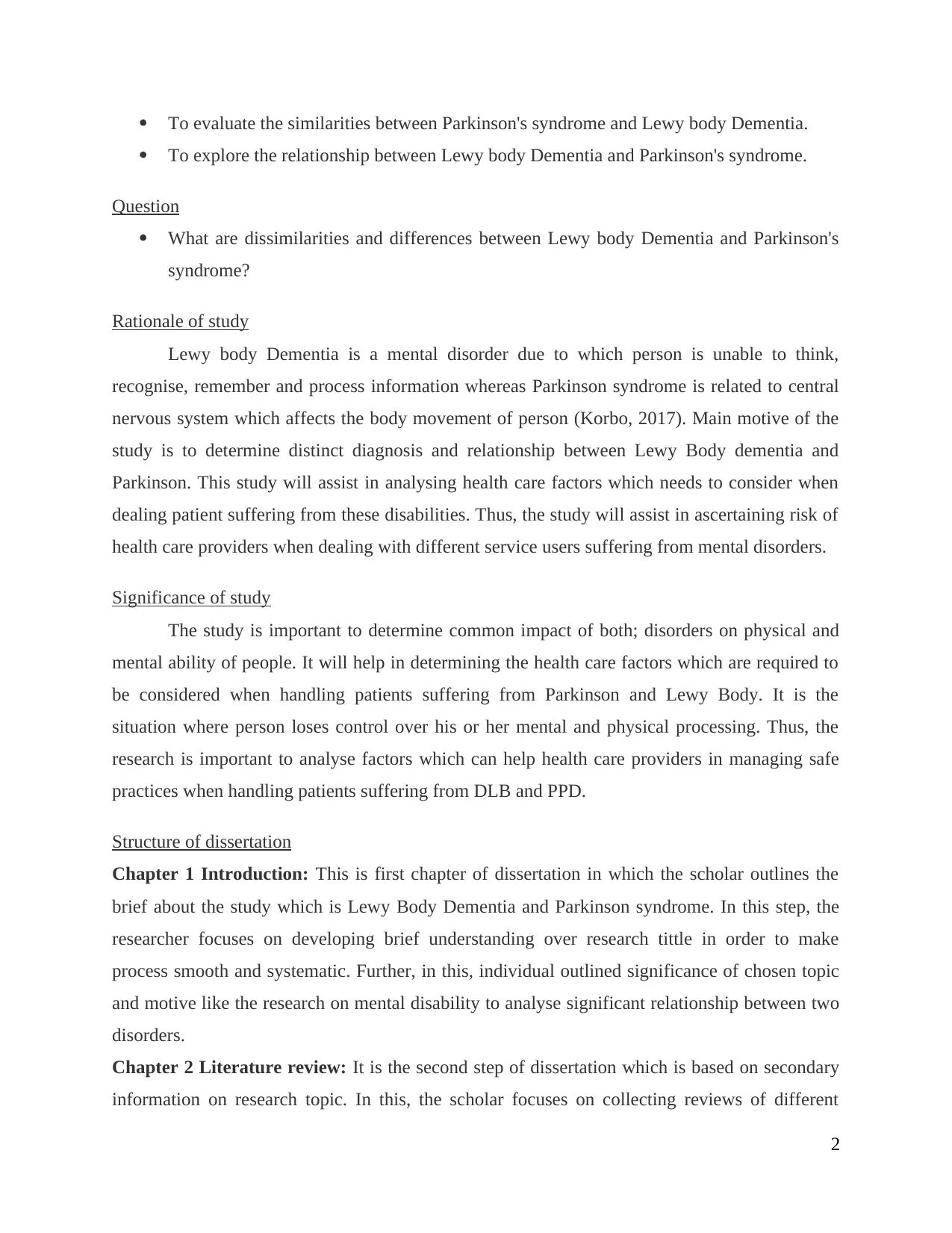
To evaluate the similarities between Parkinson's syndrome and Lewy body Dementia.
To explore the relationship between Lewy body Dementia and Parkinson's syndrome.
Question
What are dissimilarities and differences between Lewy body Dementia and Parkinson's
syndrome?
Rationale of study
Lewy body Dementia is a mental disorder due to which person is unable to think,
recognise, remember and process information whereas Parkinson syndrome is related to central
nervous system which affects the body movement of person (Korbo, 2017). Main motive of the
study is to determine distinct diagnosis and relationship between Lewy Body dementia and
Parkinson. This study will assist in analysing health care factors which needs to consider when
dealing patient suffering from these disabilities. Thus, the study will assist in ascertaining risk of
health care providers when dealing with different service users suffering from mental disorders.
Significance of study
The study is important to determine common impact of both; disorders on physical and
mental ability of people. It will help in determining the health care factors which are required to
be considered when handling patients suffering from Parkinson and Lewy Body. It is the
situation where person loses control over his or her mental and physical processing. Thus, the
research is important to analyse factors which can help health care providers in managing safe
practices when handling patients suffering from DLB and PPD.
Structure of dissertation
Chapter 1 Introduction: This is first chapter of dissertation in which the scholar outlines the
brief about the study which is Lewy Body Dementia and Parkinson syndrome. In this step, the
researcher focuses on developing brief understanding over research tittle in order to make
process smooth and systematic. Further, in this, individual outlined significance of chosen topic
and motive like the research on mental disability to analyse significant relationship between two
disorders.
Chapter 2 Literature review: It is the second step of dissertation which is based on secondary
information on research topic. In this, the scholar focuses on collecting reviews of different
2
To explore the relationship between Lewy body Dementia and Parkinson's syndrome.
Question
What are dissimilarities and differences between Lewy body Dementia and Parkinson's
syndrome?
Rationale of study
Lewy body Dementia is a mental disorder due to which person is unable to think,
recognise, remember and process information whereas Parkinson syndrome is related to central
nervous system which affects the body movement of person (Korbo, 2017). Main motive of the
study is to determine distinct diagnosis and relationship between Lewy Body dementia and
Parkinson. This study will assist in analysing health care factors which needs to consider when
dealing patient suffering from these disabilities. Thus, the study will assist in ascertaining risk of
health care providers when dealing with different service users suffering from mental disorders.
Significance of study
The study is important to determine common impact of both; disorders on physical and
mental ability of people. It will help in determining the health care factors which are required to
be considered when handling patients suffering from Parkinson and Lewy Body. It is the
situation where person loses control over his or her mental and physical processing. Thus, the
research is important to analyse factors which can help health care providers in managing safe
practices when handling patients suffering from DLB and PPD.
Structure of dissertation
Chapter 1 Introduction: This is first chapter of dissertation in which the scholar outlines the
brief about the study which is Lewy Body Dementia and Parkinson syndrome. In this step, the
researcher focuses on developing brief understanding over research tittle in order to make
process smooth and systematic. Further, in this, individual outlined significance of chosen topic
and motive like the research on mental disability to analyse significant relationship between two
disorders.
Chapter 2 Literature review: It is the second step of dissertation which is based on secondary
information on research topic. In this, the scholar focuses on collecting reviews of different
2
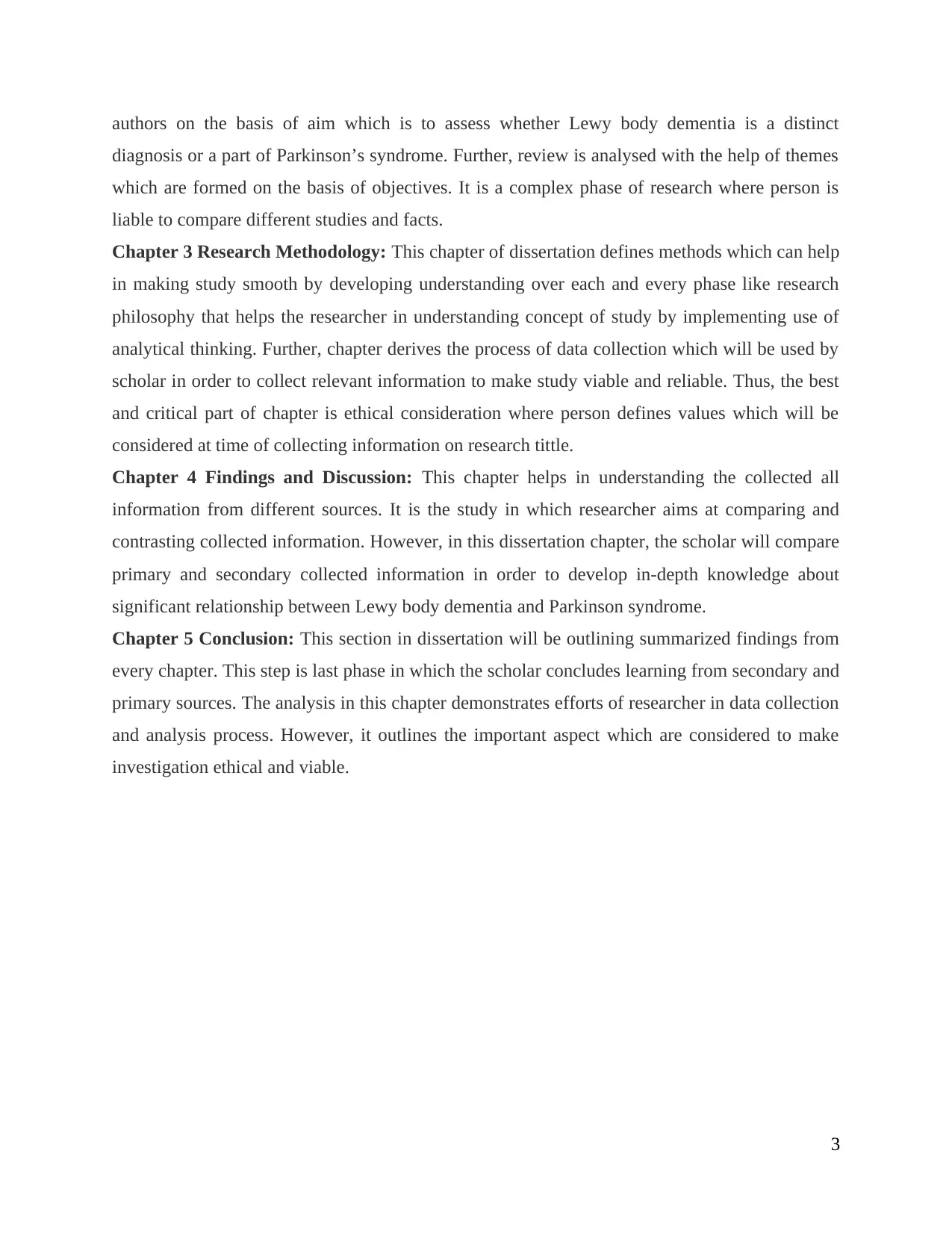
authors on the basis of aim which is to assess whether Lewy body dementia is a distinct
diagnosis or a part of Parkinson’s syndrome. Further, review is analysed with the help of themes
which are formed on the basis of objectives. It is a complex phase of research where person is
liable to compare different studies and facts.
Chapter 3 Research Methodology: This chapter of dissertation defines methods which can help
in making study smooth by developing understanding over each and every phase like research
philosophy that helps the researcher in understanding concept of study by implementing use of
analytical thinking. Further, chapter derives the process of data collection which will be used by
scholar in order to collect relevant information to make study viable and reliable. Thus, the best
and critical part of chapter is ethical consideration where person defines values which will be
considered at time of collecting information on research tittle.
Chapter 4 Findings and Discussion: This chapter helps in understanding the collected all
information from different sources. It is the study in which researcher aims at comparing and
contrasting collected information. However, in this dissertation chapter, the scholar will compare
primary and secondary collected information in order to develop in-depth knowledge about
significant relationship between Lewy body dementia and Parkinson syndrome.
Chapter 5 Conclusion: This section in dissertation will be outlining summarized findings from
every chapter. This step is last phase in which the scholar concludes learning from secondary and
primary sources. The analysis in this chapter demonstrates efforts of researcher in data collection
and analysis process. However, it outlines the important aspect which are considered to make
investigation ethical and viable.
3
diagnosis or a part of Parkinson’s syndrome. Further, review is analysed with the help of themes
which are formed on the basis of objectives. It is a complex phase of research where person is
liable to compare different studies and facts.
Chapter 3 Research Methodology: This chapter of dissertation defines methods which can help
in making study smooth by developing understanding over each and every phase like research
philosophy that helps the researcher in understanding concept of study by implementing use of
analytical thinking. Further, chapter derives the process of data collection which will be used by
scholar in order to collect relevant information to make study viable and reliable. Thus, the best
and critical part of chapter is ethical consideration where person defines values which will be
considered at time of collecting information on research tittle.
Chapter 4 Findings and Discussion: This chapter helps in understanding the collected all
information from different sources. It is the study in which researcher aims at comparing and
contrasting collected information. However, in this dissertation chapter, the scholar will compare
primary and secondary collected information in order to develop in-depth knowledge about
significant relationship between Lewy body dementia and Parkinson syndrome.
Chapter 5 Conclusion: This section in dissertation will be outlining summarized findings from
every chapter. This step is last phase in which the scholar concludes learning from secondary and
primary sources. The analysis in this chapter demonstrates efforts of researcher in data collection
and analysis process. However, it outlines the important aspect which are considered to make
investigation ethical and viable.
3
⊘ This is a preview!⊘
Do you want full access?
Subscribe today to unlock all pages.

Trusted by 1+ million students worldwide
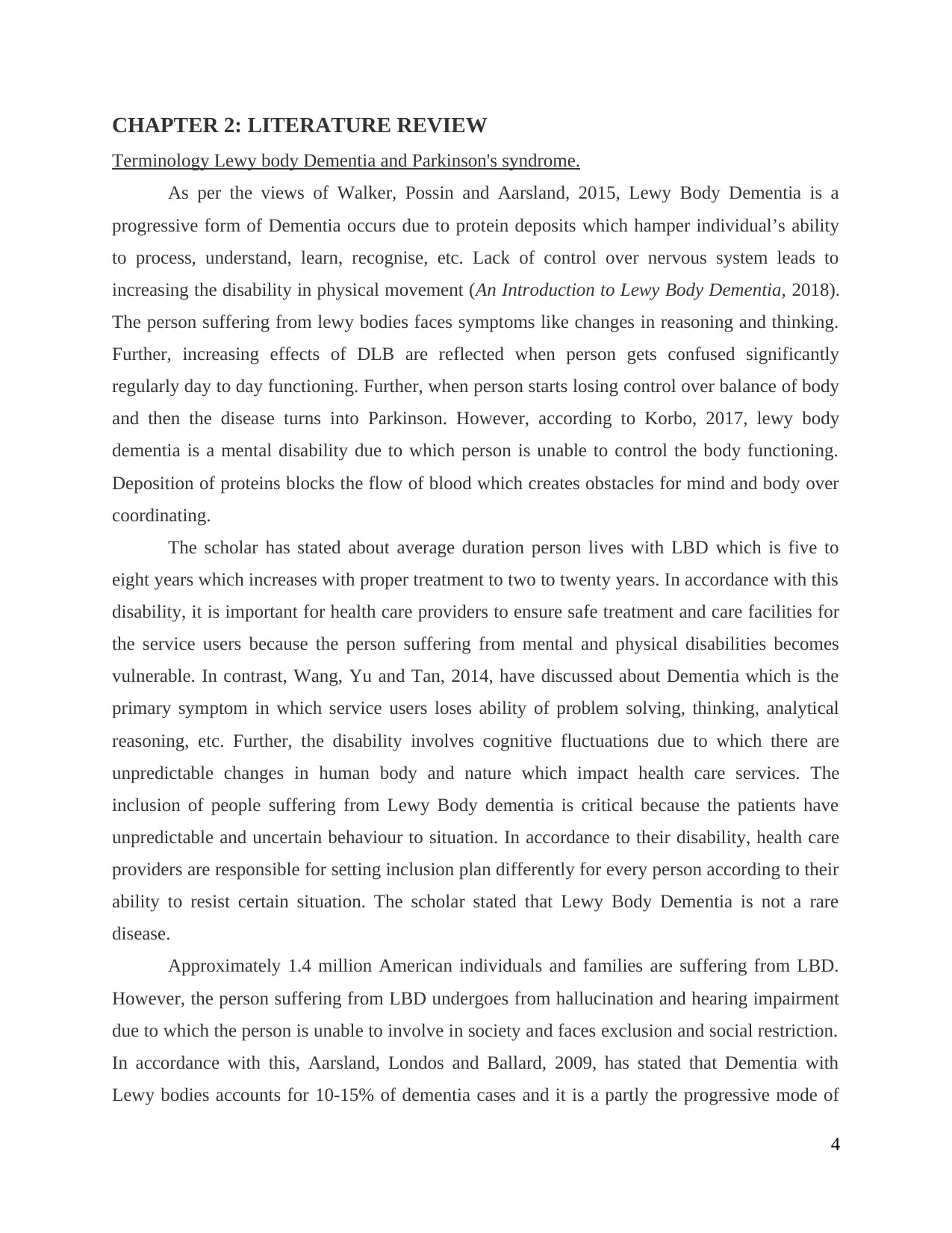
CHAPTER 2: LITERATURE REVIEW
Terminology Lewy body Dementia and Parkinson's syndrome.
As per the views of Walker, Possin and Aarsland, 2015, Lewy Body Dementia is a
progressive form of Dementia occurs due to protein deposits which hamper individual’s ability
to process, understand, learn, recognise, etc. Lack of control over nervous system leads to
increasing the disability in physical movement (An Introduction to Lewy Body Dementia, 2018).
The person suffering from lewy bodies faces symptoms like changes in reasoning and thinking.
Further, increasing effects of DLB are reflected when person gets confused significantly
regularly day to day functioning. Further, when person starts losing control over balance of body
and then the disease turns into Parkinson. However, according to Korbo, 2017, lewy body
dementia is a mental disability due to which person is unable to control the body functioning.
Deposition of proteins blocks the flow of blood which creates obstacles for mind and body over
coordinating.
The scholar has stated about average duration person lives with LBD which is five to
eight years which increases with proper treatment to two to twenty years. In accordance with this
disability, it is important for health care providers to ensure safe treatment and care facilities for
the service users because the person suffering from mental and physical disabilities becomes
vulnerable. In contrast, Wang, Yu and Tan, 2014, have discussed about Dementia which is the
primary symptom in which service users loses ability of problem solving, thinking, analytical
reasoning, etc. Further, the disability involves cognitive fluctuations due to which there are
unpredictable changes in human body and nature which impact health care services. The
inclusion of people suffering from Lewy Body dementia is critical because the patients have
unpredictable and uncertain behaviour to situation. In accordance to their disability, health care
providers are responsible for setting inclusion plan differently for every person according to their
ability to resist certain situation. The scholar stated that Lewy Body Dementia is not a rare
disease.
Approximately 1.4 million American individuals and families are suffering from LBD.
However, the person suffering from LBD undergoes from hallucination and hearing impairment
due to which the person is unable to involve in society and faces exclusion and social restriction.
In accordance with this, Aarsland, Londos and Ballard, 2009, has stated that Dementia with
Lewy bodies accounts for 10-15% of dementia cases and it is a partly the progressive mode of
4
Terminology Lewy body Dementia and Parkinson's syndrome.
As per the views of Walker, Possin and Aarsland, 2015, Lewy Body Dementia is a
progressive form of Dementia occurs due to protein deposits which hamper individual’s ability
to process, understand, learn, recognise, etc. Lack of control over nervous system leads to
increasing the disability in physical movement (An Introduction to Lewy Body Dementia, 2018).
The person suffering from lewy bodies faces symptoms like changes in reasoning and thinking.
Further, increasing effects of DLB are reflected when person gets confused significantly
regularly day to day functioning. Further, when person starts losing control over balance of body
and then the disease turns into Parkinson. However, according to Korbo, 2017, lewy body
dementia is a mental disability due to which person is unable to control the body functioning.
Deposition of proteins blocks the flow of blood which creates obstacles for mind and body over
coordinating.
The scholar has stated about average duration person lives with LBD which is five to
eight years which increases with proper treatment to two to twenty years. In accordance with this
disability, it is important for health care providers to ensure safe treatment and care facilities for
the service users because the person suffering from mental and physical disabilities becomes
vulnerable. In contrast, Wang, Yu and Tan, 2014, have discussed about Dementia which is the
primary symptom in which service users loses ability of problem solving, thinking, analytical
reasoning, etc. Further, the disability involves cognitive fluctuations due to which there are
unpredictable changes in human body and nature which impact health care services. The
inclusion of people suffering from Lewy Body dementia is critical because the patients have
unpredictable and uncertain behaviour to situation. In accordance to their disability, health care
providers are responsible for setting inclusion plan differently for every person according to their
ability to resist certain situation. The scholar stated that Lewy Body Dementia is not a rare
disease.
Approximately 1.4 million American individuals and families are suffering from LBD.
However, the person suffering from LBD undergoes from hallucination and hearing impairment
due to which the person is unable to involve in society and faces exclusion and social restriction.
In accordance with this, Aarsland, Londos and Ballard, 2009, has stated that Dementia with
Lewy bodies accounts for 10-15% of dementia cases and it is a partly the progressive mode of
4
Paraphrase This Document
Need a fresh take? Get an instant paraphrase of this document with our AI Paraphraser
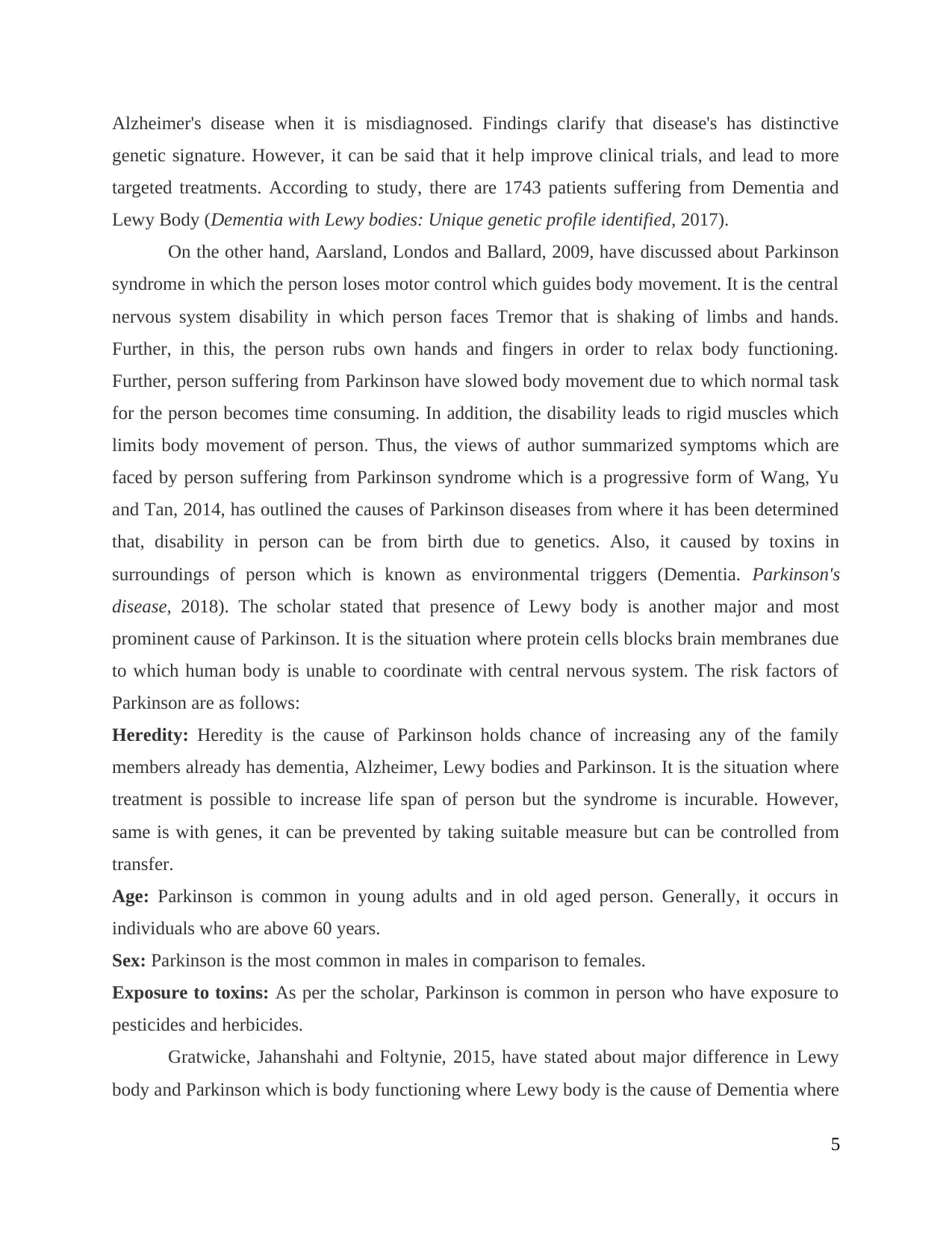
Alzheimer's disease when it is misdiagnosed. Findings clarify that disease's has distinctive
genetic signature. However, it can be said that it help improve clinical trials, and lead to more
targeted treatments. According to study, there are 1743 patients suffering from Dementia and
Lewy Body (Dementia with Lewy bodies: Unique genetic profile identified, 2017).
On the other hand, Aarsland, Londos and Ballard, 2009, have discussed about Parkinson
syndrome in which the person loses motor control which guides body movement. It is the central
nervous system disability in which person faces Tremor that is shaking of limbs and hands.
Further, in this, the person rubs own hands and fingers in order to relax body functioning.
Further, person suffering from Parkinson have slowed body movement due to which normal task
for the person becomes time consuming. In addition, the disability leads to rigid muscles which
limits body movement of person. Thus, the views of author summarized symptoms which are
faced by person suffering from Parkinson syndrome which is a progressive form of Wang, Yu
and Tan, 2014, has outlined the causes of Parkinson diseases from where it has been determined
that, disability in person can be from birth due to genetics. Also, it caused by toxins in
surroundings of person which is known as environmental triggers (Dementia. Parkinson's
disease, 2018). The scholar stated that presence of Lewy body is another major and most
prominent cause of Parkinson. It is the situation where protein cells blocks brain membranes due
to which human body is unable to coordinate with central nervous system. The risk factors of
Parkinson are as follows:
Heredity: Heredity is the cause of Parkinson holds chance of increasing any of the family
members already has dementia, Alzheimer, Lewy bodies and Parkinson. It is the situation where
treatment is possible to increase life span of person but the syndrome is incurable. However,
same is with genes, it can be prevented by taking suitable measure but can be controlled from
transfer.
Age: Parkinson is common in young adults and in old aged person. Generally, it occurs in
individuals who are above 60 years.
Sex: Parkinson is the most common in males in comparison to females.
Exposure to toxins: As per the scholar, Parkinson is common in person who have exposure to
pesticides and herbicides.
Gratwicke, Jahanshahi and Foltynie, 2015, have stated about major difference in Lewy
body and Parkinson which is body functioning where Lewy body is the cause of Dementia where
5
genetic signature. However, it can be said that it help improve clinical trials, and lead to more
targeted treatments. According to study, there are 1743 patients suffering from Dementia and
Lewy Body (Dementia with Lewy bodies: Unique genetic profile identified, 2017).
On the other hand, Aarsland, Londos and Ballard, 2009, have discussed about Parkinson
syndrome in which the person loses motor control which guides body movement. It is the central
nervous system disability in which person faces Tremor that is shaking of limbs and hands.
Further, in this, the person rubs own hands and fingers in order to relax body functioning.
Further, person suffering from Parkinson have slowed body movement due to which normal task
for the person becomes time consuming. In addition, the disability leads to rigid muscles which
limits body movement of person. Thus, the views of author summarized symptoms which are
faced by person suffering from Parkinson syndrome which is a progressive form of Wang, Yu
and Tan, 2014, has outlined the causes of Parkinson diseases from where it has been determined
that, disability in person can be from birth due to genetics. Also, it caused by toxins in
surroundings of person which is known as environmental triggers (Dementia. Parkinson's
disease, 2018). The scholar stated that presence of Lewy body is another major and most
prominent cause of Parkinson. It is the situation where protein cells blocks brain membranes due
to which human body is unable to coordinate with central nervous system. The risk factors of
Parkinson are as follows:
Heredity: Heredity is the cause of Parkinson holds chance of increasing any of the family
members already has dementia, Alzheimer, Lewy bodies and Parkinson. It is the situation where
treatment is possible to increase life span of person but the syndrome is incurable. However,
same is with genes, it can be prevented by taking suitable measure but can be controlled from
transfer.
Age: Parkinson is common in young adults and in old aged person. Generally, it occurs in
individuals who are above 60 years.
Sex: Parkinson is the most common in males in comparison to females.
Exposure to toxins: As per the scholar, Parkinson is common in person who have exposure to
pesticides and herbicides.
Gratwicke, Jahanshahi and Foltynie, 2015, have stated about major difference in Lewy
body and Parkinson which is body functioning where Lewy body is the cause of Dementia where
5
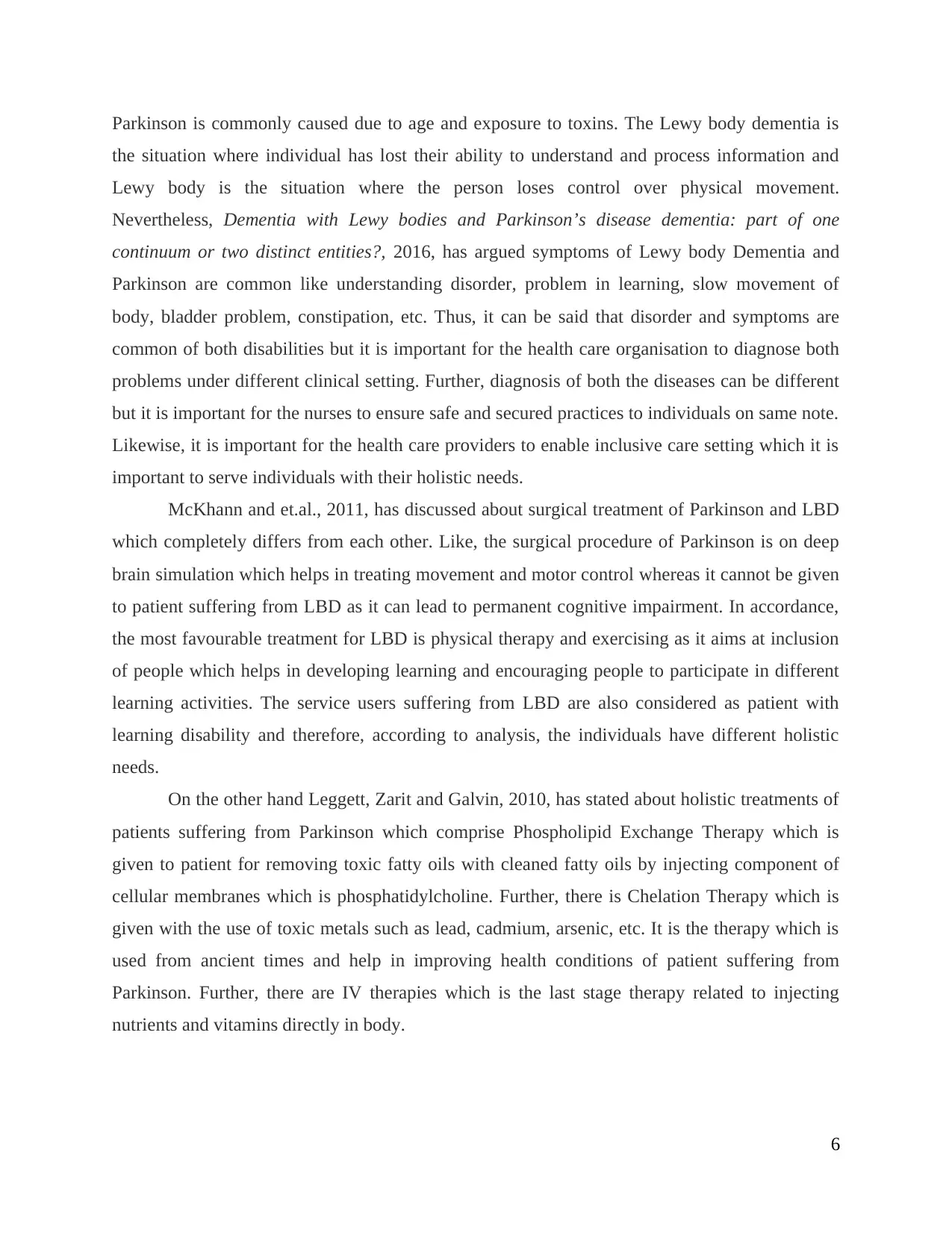
Parkinson is commonly caused due to age and exposure to toxins. The Lewy body dementia is
the situation where individual has lost their ability to understand and process information and
Lewy body is the situation where the person loses control over physical movement.
Nevertheless, Dementia with Lewy bodies and Parkinson’s disease dementia: part of one
continuum or two distinct entities?, 2016, has argued symptoms of Lewy body Dementia and
Parkinson are common like understanding disorder, problem in learning, slow movement of
body, bladder problem, constipation, etc. Thus, it can be said that disorder and symptoms are
common of both disabilities but it is important for the health care organisation to diagnose both
problems under different clinical setting. Further, diagnosis of both the diseases can be different
but it is important for the nurses to ensure safe and secured practices to individuals on same note.
Likewise, it is important for the health care providers to enable inclusive care setting which it is
important to serve individuals with their holistic needs.
McKhann and et.al., 2011, has discussed about surgical treatment of Parkinson and LBD
which completely differs from each other. Like, the surgical procedure of Parkinson is on deep
brain simulation which helps in treating movement and motor control whereas it cannot be given
to patient suffering from LBD as it can lead to permanent cognitive impairment. In accordance,
the most favourable treatment for LBD is physical therapy and exercising as it aims at inclusion
of people which helps in developing learning and encouraging people to participate in different
learning activities. The service users suffering from LBD are also considered as patient with
learning disability and therefore, according to analysis, the individuals have different holistic
needs.
On the other hand Leggett, Zarit and Galvin, 2010, has stated about holistic treatments of
patients suffering from Parkinson which comprise Phospholipid Exchange Therapy which is
given to patient for removing toxic fatty oils with cleaned fatty oils by injecting component of
cellular membranes which is phosphatidylcholine. Further, there is Chelation Therapy which is
given with the use of toxic metals such as lead, cadmium, arsenic, etc. It is the therapy which is
used from ancient times and help in improving health conditions of patient suffering from
Parkinson. Further, there are IV therapies which is the last stage therapy related to injecting
nutrients and vitamins directly in body.
6
the situation where individual has lost their ability to understand and process information and
Lewy body is the situation where the person loses control over physical movement.
Nevertheless, Dementia with Lewy bodies and Parkinson’s disease dementia: part of one
continuum or two distinct entities?, 2016, has argued symptoms of Lewy body Dementia and
Parkinson are common like understanding disorder, problem in learning, slow movement of
body, bladder problem, constipation, etc. Thus, it can be said that disorder and symptoms are
common of both disabilities but it is important for the health care organisation to diagnose both
problems under different clinical setting. Further, diagnosis of both the diseases can be different
but it is important for the nurses to ensure safe and secured practices to individuals on same note.
Likewise, it is important for the health care providers to enable inclusive care setting which it is
important to serve individuals with their holistic needs.
McKhann and et.al., 2011, has discussed about surgical treatment of Parkinson and LBD
which completely differs from each other. Like, the surgical procedure of Parkinson is on deep
brain simulation which helps in treating movement and motor control whereas it cannot be given
to patient suffering from LBD as it can lead to permanent cognitive impairment. In accordance,
the most favourable treatment for LBD is physical therapy and exercising as it aims at inclusion
of people which helps in developing learning and encouraging people to participate in different
learning activities. The service users suffering from LBD are also considered as patient with
learning disability and therefore, according to analysis, the individuals have different holistic
needs.
On the other hand Leggett, Zarit and Galvin, 2010, has stated about holistic treatments of
patients suffering from Parkinson which comprise Phospholipid Exchange Therapy which is
given to patient for removing toxic fatty oils with cleaned fatty oils by injecting component of
cellular membranes which is phosphatidylcholine. Further, there is Chelation Therapy which is
given with the use of toxic metals such as lead, cadmium, arsenic, etc. It is the therapy which is
used from ancient times and help in improving health conditions of patient suffering from
Parkinson. Further, there are IV therapies which is the last stage therapy related to injecting
nutrients and vitamins directly in body.
6
⊘ This is a preview!⊘
Do you want full access?
Subscribe today to unlock all pages.

Trusted by 1+ million students worldwide
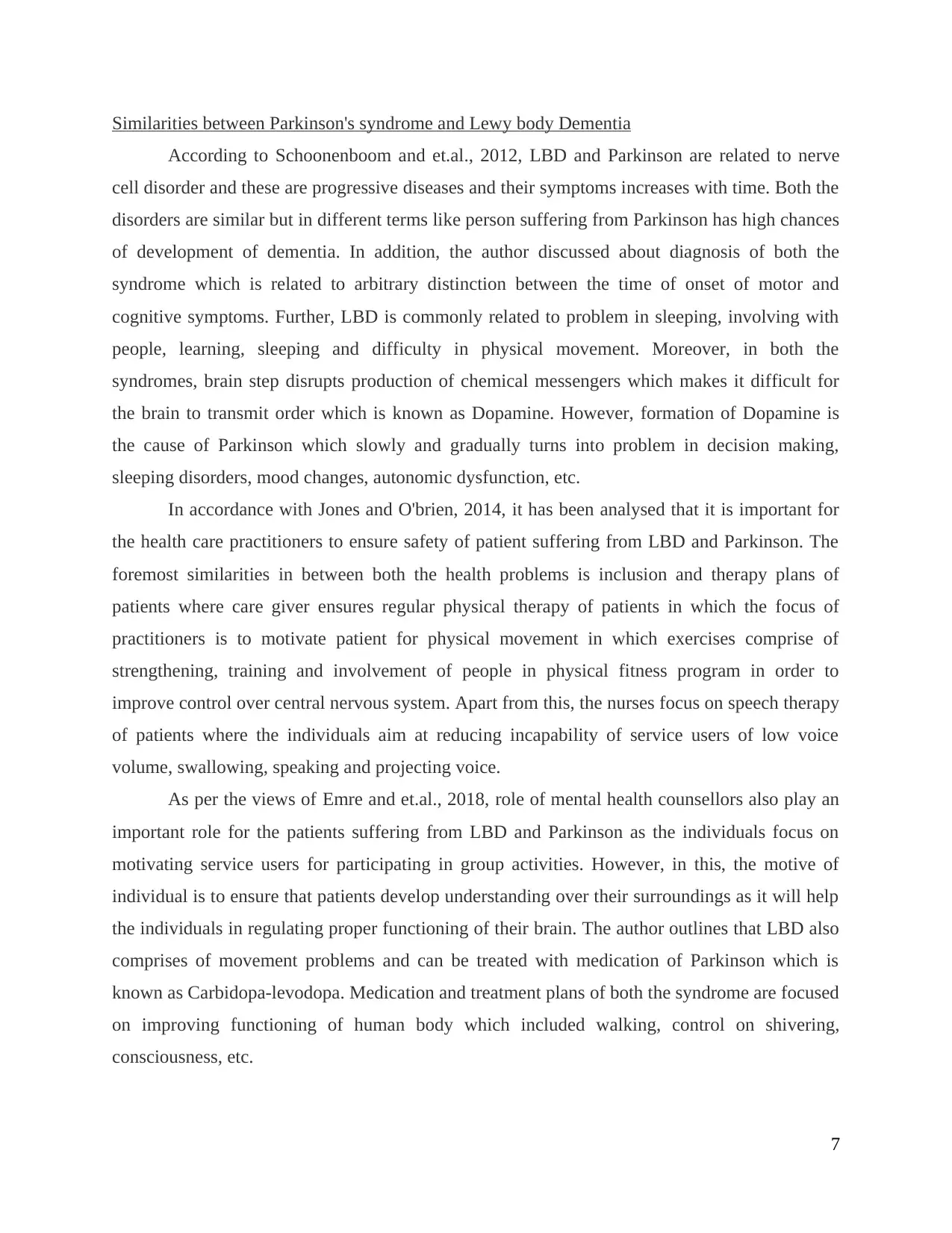
Similarities between Parkinson's syndrome and Lewy body Dementia
According to Schoonenboom and et.al., 2012, LBD and Parkinson are related to nerve
cell disorder and these are progressive diseases and their symptoms increases with time. Both the
disorders are similar but in different terms like person suffering from Parkinson has high chances
of development of dementia. In addition, the author discussed about diagnosis of both the
syndrome which is related to arbitrary distinction between the time of onset of motor and
cognitive symptoms. Further, LBD is commonly related to problem in sleeping, involving with
people, learning, sleeping and difficulty in physical movement. Moreover, in both the
syndromes, brain step disrupts production of chemical messengers which makes it difficult for
the brain to transmit order which is known as Dopamine. However, formation of Dopamine is
the cause of Parkinson which slowly and gradually turns into problem in decision making,
sleeping disorders, mood changes, autonomic dysfunction, etc.
In accordance with Jones and O'brien, 2014, it has been analysed that it is important for
the health care practitioners to ensure safety of patient suffering from LBD and Parkinson. The
foremost similarities in between both the health problems is inclusion and therapy plans of
patients where care giver ensures regular physical therapy of patients in which the focus of
practitioners is to motivate patient for physical movement in which exercises comprise of
strengthening, training and involvement of people in physical fitness program in order to
improve control over central nervous system. Apart from this, the nurses focus on speech therapy
of patients where the individuals aim at reducing incapability of service users of low voice
volume, swallowing, speaking and projecting voice.
As per the views of Emre and et.al., 2018, role of mental health counsellors also play an
important role for the patients suffering from LBD and Parkinson as the individuals focus on
motivating service users for participating in group activities. However, in this, the motive of
individual is to ensure that patients develop understanding over their surroundings as it will help
the individuals in regulating proper functioning of their brain. The author outlines that LBD also
comprises of movement problems and can be treated with medication of Parkinson which is
known as Carbidopa-levodopa. Medication and treatment plans of both the syndrome are focused
on improving functioning of human body which included walking, control on shivering,
consciousness, etc.
7
According to Schoonenboom and et.al., 2012, LBD and Parkinson are related to nerve
cell disorder and these are progressive diseases and their symptoms increases with time. Both the
disorders are similar but in different terms like person suffering from Parkinson has high chances
of development of dementia. In addition, the author discussed about diagnosis of both the
syndrome which is related to arbitrary distinction between the time of onset of motor and
cognitive symptoms. Further, LBD is commonly related to problem in sleeping, involving with
people, learning, sleeping and difficulty in physical movement. Moreover, in both the
syndromes, brain step disrupts production of chemical messengers which makes it difficult for
the brain to transmit order which is known as Dopamine. However, formation of Dopamine is
the cause of Parkinson which slowly and gradually turns into problem in decision making,
sleeping disorders, mood changes, autonomic dysfunction, etc.
In accordance with Jones and O'brien, 2014, it has been analysed that it is important for
the health care practitioners to ensure safety of patient suffering from LBD and Parkinson. The
foremost similarities in between both the health problems is inclusion and therapy plans of
patients where care giver ensures regular physical therapy of patients in which the focus of
practitioners is to motivate patient for physical movement in which exercises comprise of
strengthening, training and involvement of people in physical fitness program in order to
improve control over central nervous system. Apart from this, the nurses focus on speech therapy
of patients where the individuals aim at reducing incapability of service users of low voice
volume, swallowing, speaking and projecting voice.
As per the views of Emre and et.al., 2018, role of mental health counsellors also play an
important role for the patients suffering from LBD and Parkinson as the individuals focus on
motivating service users for participating in group activities. However, in this, the motive of
individual is to ensure that patients develop understanding over their surroundings as it will help
the individuals in regulating proper functioning of their brain. The author outlines that LBD also
comprises of movement problems and can be treated with medication of Parkinson which is
known as Carbidopa-levodopa. Medication and treatment plans of both the syndrome are focused
on improving functioning of human body which included walking, control on shivering,
consciousness, etc.
7
Paraphrase This Document
Need a fresh take? Get an instant paraphrase of this document with our AI Paraphraser
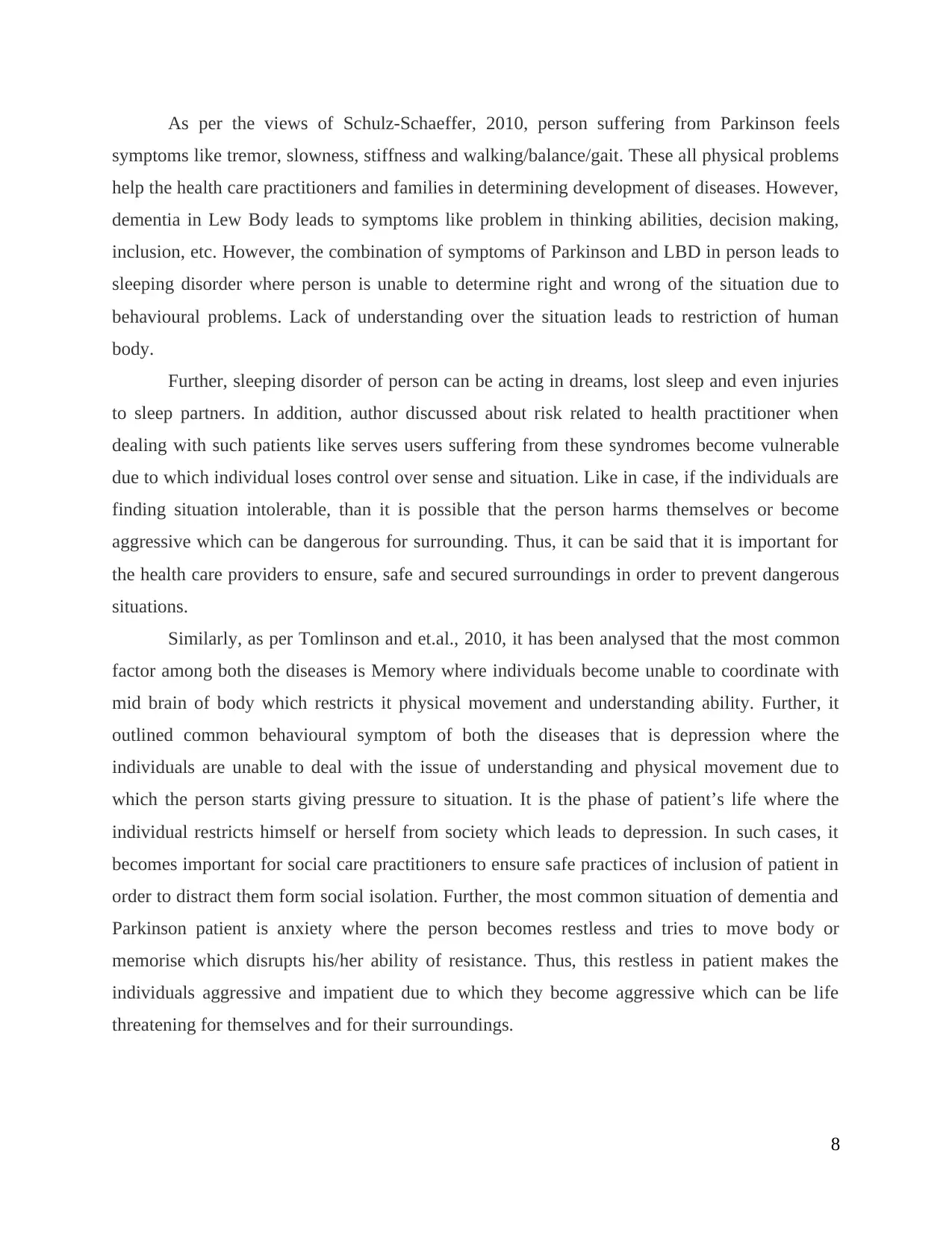
As per the views of Schulz-Schaeffer, 2010, person suffering from Parkinson feels
symptoms like tremor, slowness, stiffness and walking/balance/gait. These all physical problems
help the health care practitioners and families in determining development of diseases. However,
dementia in Lew Body leads to symptoms like problem in thinking abilities, decision making,
inclusion, etc. However, the combination of symptoms of Parkinson and LBD in person leads to
sleeping disorder where person is unable to determine right and wrong of the situation due to
behavioural problems. Lack of understanding over the situation leads to restriction of human
body.
Further, sleeping disorder of person can be acting in dreams, lost sleep and even injuries
to sleep partners. In addition, author discussed about risk related to health practitioner when
dealing with such patients like serves users suffering from these syndromes become vulnerable
due to which individual loses control over sense and situation. Like in case, if the individuals are
finding situation intolerable, than it is possible that the person harms themselves or become
aggressive which can be dangerous for surrounding. Thus, it can be said that it is important for
the health care providers to ensure, safe and secured surroundings in order to prevent dangerous
situations.
Similarly, as per Tomlinson and et.al., 2010, it has been analysed that the most common
factor among both the diseases is Memory where individuals become unable to coordinate with
mid brain of body which restricts it physical movement and understanding ability. Further, it
outlined common behavioural symptom of both the diseases that is depression where the
individuals are unable to deal with the issue of understanding and physical movement due to
which the person starts giving pressure to situation. It is the phase of patient’s life where the
individual restricts himself or herself from society which leads to depression. In such cases, it
becomes important for social care practitioners to ensure safe practices of inclusion of patient in
order to distract them form social isolation. Further, the most common situation of dementia and
Parkinson patient is anxiety where the person becomes restless and tries to move body or
memorise which disrupts his/her ability of resistance. Thus, this restless in patient makes the
individuals aggressive and impatient due to which they become aggressive which can be life
threatening for themselves and for their surroundings.
8
symptoms like tremor, slowness, stiffness and walking/balance/gait. These all physical problems
help the health care practitioners and families in determining development of diseases. However,
dementia in Lew Body leads to symptoms like problem in thinking abilities, decision making,
inclusion, etc. However, the combination of symptoms of Parkinson and LBD in person leads to
sleeping disorder where person is unable to determine right and wrong of the situation due to
behavioural problems. Lack of understanding over the situation leads to restriction of human
body.
Further, sleeping disorder of person can be acting in dreams, lost sleep and even injuries
to sleep partners. In addition, author discussed about risk related to health practitioner when
dealing with such patients like serves users suffering from these syndromes become vulnerable
due to which individual loses control over sense and situation. Like in case, if the individuals are
finding situation intolerable, than it is possible that the person harms themselves or become
aggressive which can be dangerous for surrounding. Thus, it can be said that it is important for
the health care providers to ensure, safe and secured surroundings in order to prevent dangerous
situations.
Similarly, as per Tomlinson and et.al., 2010, it has been analysed that the most common
factor among both the diseases is Memory where individuals become unable to coordinate with
mid brain of body which restricts it physical movement and understanding ability. Further, it
outlined common behavioural symptom of both the diseases that is depression where the
individuals are unable to deal with the issue of understanding and physical movement due to
which the person starts giving pressure to situation. It is the phase of patient’s life where the
individual restricts himself or herself from society which leads to depression. In such cases, it
becomes important for social care practitioners to ensure safe practices of inclusion of patient in
order to distract them form social isolation. Further, the most common situation of dementia and
Parkinson patient is anxiety where the person becomes restless and tries to move body or
memorise which disrupts his/her ability of resistance. Thus, this restless in patient makes the
individuals aggressive and impatient due to which they become aggressive which can be life
threatening for themselves and for their surroundings.
8
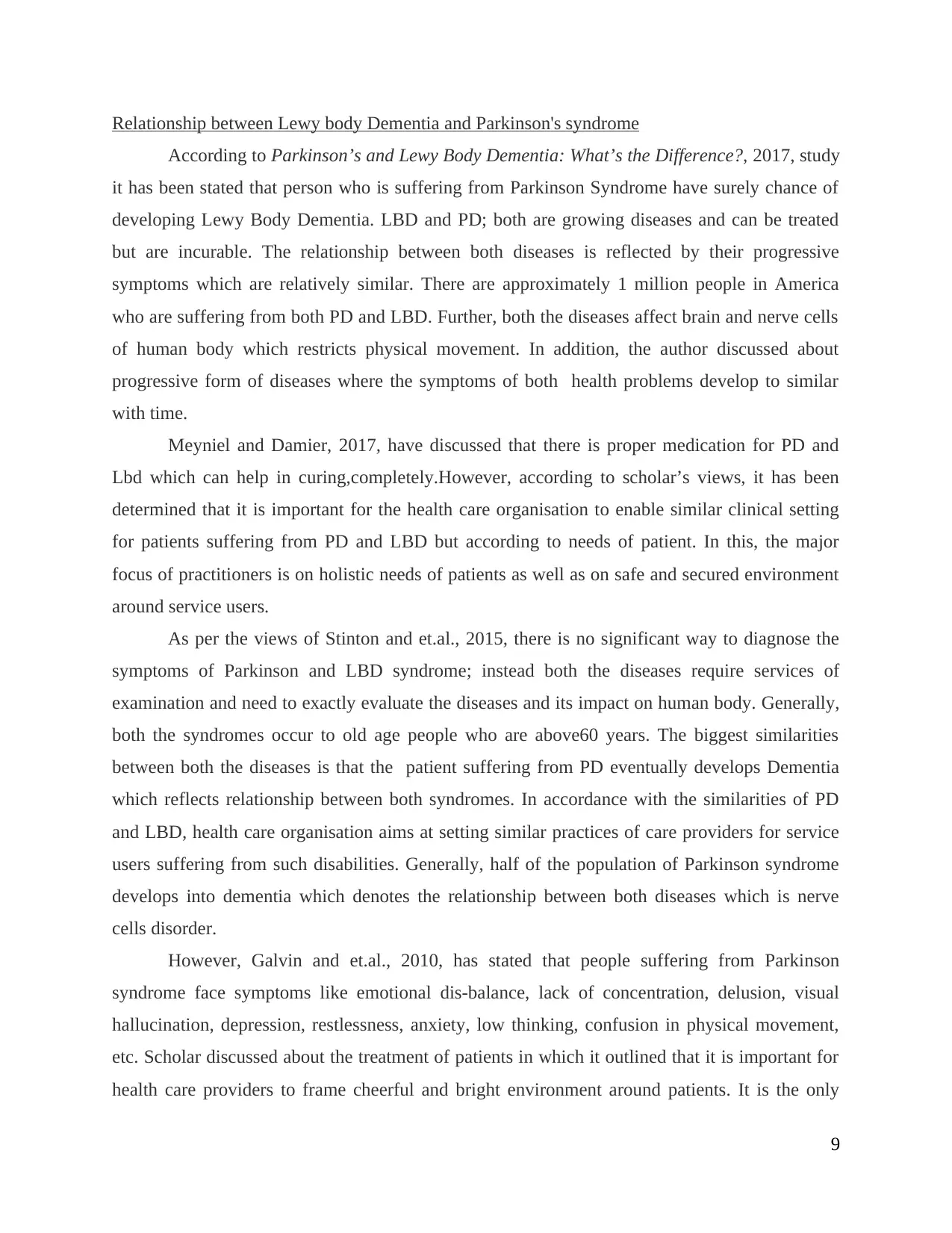
Relationship between Lewy body Dementia and Parkinson's syndrome
According to Parkinson’s and Lewy Body Dementia: What’s the Difference?, 2017, study
it has been stated that person who is suffering from Parkinson Syndrome have surely chance of
developing Lewy Body Dementia. LBD and PD; both are growing diseases and can be treated
but are incurable. The relationship between both diseases is reflected by their progressive
symptoms which are relatively similar. There are approximately 1 million people in America
who are suffering from both PD and LBD. Further, both the diseases affect brain and nerve cells
of human body which restricts physical movement. In addition, the author discussed about
progressive form of diseases where the symptoms of both health problems develop to similar
with time.
Meyniel and Damier, 2017, have discussed that there is proper medication for PD and
Lbd which can help in curing,completely.However, according to scholar’s views, it has been
determined that it is important for the health care organisation to enable similar clinical setting
for patients suffering from PD and LBD but according to needs of patient. In this, the major
focus of practitioners is on holistic needs of patients as well as on safe and secured environment
around service users.
As per the views of Stinton and et.al., 2015, there is no significant way to diagnose the
symptoms of Parkinson and LBD syndrome; instead both the diseases require services of
examination and need to exactly evaluate the diseases and its impact on human body. Generally,
both the syndromes occur to old age people who are above60 years. The biggest similarities
between both the diseases is that the patient suffering from PD eventually develops Dementia
which reflects relationship between both syndromes. In accordance with the similarities of PD
and LBD, health care organisation aims at setting similar practices of care providers for service
users suffering from such disabilities. Generally, half of the population of Parkinson syndrome
develops into dementia which denotes the relationship between both diseases which is nerve
cells disorder.
However, Galvin and et.al., 2010, has stated that people suffering from Parkinson
syndrome face symptoms like emotional dis-balance, lack of concentration, delusion, visual
hallucination, depression, restlessness, anxiety, low thinking, confusion in physical movement,
etc. Scholar discussed about the treatment of patients in which it outlined that it is important for
health care providers to frame cheerful and bright environment around patients. It is the only
9
According to Parkinson’s and Lewy Body Dementia: What’s the Difference?, 2017, study
it has been stated that person who is suffering from Parkinson Syndrome have surely chance of
developing Lewy Body Dementia. LBD and PD; both are growing diseases and can be treated
but are incurable. The relationship between both diseases is reflected by their progressive
symptoms which are relatively similar. There are approximately 1 million people in America
who are suffering from both PD and LBD. Further, both the diseases affect brain and nerve cells
of human body which restricts physical movement. In addition, the author discussed about
progressive form of diseases where the symptoms of both health problems develop to similar
with time.
Meyniel and Damier, 2017, have discussed that there is proper medication for PD and
Lbd which can help in curing,completely.However, according to scholar’s views, it has been
determined that it is important for the health care organisation to enable similar clinical setting
for patients suffering from PD and LBD but according to needs of patient. In this, the major
focus of practitioners is on holistic needs of patients as well as on safe and secured environment
around service users.
As per the views of Stinton and et.al., 2015, there is no significant way to diagnose the
symptoms of Parkinson and LBD syndrome; instead both the diseases require services of
examination and need to exactly evaluate the diseases and its impact on human body. Generally,
both the syndromes occur to old age people who are above60 years. The biggest similarities
between both the diseases is that the patient suffering from PD eventually develops Dementia
which reflects relationship between both syndromes. In accordance with the similarities of PD
and LBD, health care organisation aims at setting similar practices of care providers for service
users suffering from such disabilities. Generally, half of the population of Parkinson syndrome
develops into dementia which denotes the relationship between both diseases which is nerve
cells disorder.
However, Galvin and et.al., 2010, has stated that people suffering from Parkinson
syndrome face symptoms like emotional dis-balance, lack of concentration, delusion, visual
hallucination, depression, restlessness, anxiety, low thinking, confusion in physical movement,
etc. Scholar discussed about the treatment of patients in which it outlined that it is important for
health care providers to frame cheerful and bright environment around patients. It is the only
9
⊘ This is a preview!⊘
Do you want full access?
Subscribe today to unlock all pages.

Trusted by 1+ million students worldwide
1 out of 30
Related Documents
Your All-in-One AI-Powered Toolkit for Academic Success.
+13062052269
info@desklib.com
Available 24*7 on WhatsApp / Email
![[object Object]](/_next/static/media/star-bottom.7253800d.svg)
Unlock your academic potential
Copyright © 2020–2025 A2Z Services. All Rights Reserved. Developed and managed by ZUCOL.





